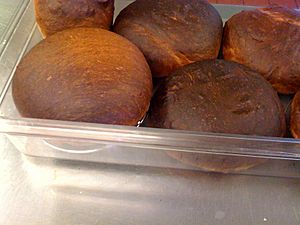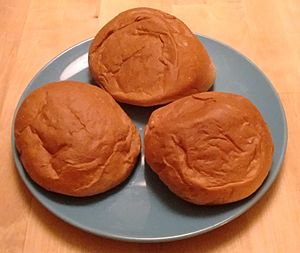Portuguese sweet bread facts for kids
 |
|
| Alternative names | pão doce, massa sovada |
|---|---|
| Type | bread |
| Course | dessert |
| Place of origin | Portugal |
| Associated national cuisine | Portuguese cuisine |
| Main ingredients | milk, sugar, flour, eggs, butter, yeast, salt |
Portuguese sweet bread (Portuguese: pão doce "sweet bread" or massa sovada "kneaded dough") is a bread made with milk, sugar, eggs, yeast, flour and sometimes lemon peel to produce a subtly sweet lightly textured loaf or rolls. A slightly different recipe is made during Easter that is known as folar and often contains a hard-boiled egg.
Portuguese sweet bread is traditionally made around Christmas, and the Easter version is made around Easter, but it is also available year-round. It is traditionally baked in a stone oven known as a forno.
The bread is usually served simply with butter and is sometimes served with a rice pudding known as arroz doce.
Portuguese sweet bread is common in areas with large populations of Portuguese Americans and Portuguese Canadians, such as New England, Hawaii, northern New Jersey, southern Florida, California, and Ontario, Canada especially Toronto, and it is prominent in Hawaiian and New England cuisines. At one time, Hawaii featured numerous fornos for baking Portuguese breads constructed by Portuguese immigrants. The California-based company King's Hawaiian and numerous regional bakeries produce Portuguese sweet bread.
See also
 In Spanish: Pan dulce portugués para niños
In Spanish: Pan dulce portugués para niños


